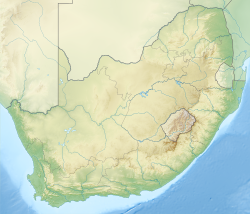Soom Shale
| Soom Shale | |
|---|---|
| Stratigraphic range: Hirnantian | |
 Typical lithological features of the Soom shale, note the frequent beds of white quartz | |
| Unit of | Cederberg Formation, Table Mountain Group |
| Underlies | Disa Siltstone |
| Overlies | Pakhuis Tillite |
| Thickness | 10–15 m (33–49 ft) |
| Lithology | |
| Primary | Shale |
| Location | |
| Coordinates | 33°00′S 19°00′E / 33.0°S 19.0°E |
| Approximate paleocoordinates | 28°30′S 153°42′E / 28.5°S 153.7°E |
| Region | Western Cape |
| Country | |
The Soom Shale is a member of the Late Ordovician (Hirnantian) Cederberg Formation (Table Mountain Group) in South Africa, renowned for its remarkable preservation of soft-tissue in fossil material.[1] Deposited in still waters, the unit lacks bioturbation, perhaps indicating anoxic conditions.[1]
It overlies the Pakhuis tillite and is overlain by the Disa Siltstone.[1]
It contains typical Ordovician microfossils, such as chitinozoa, acritarchs and spores, and its shelly fauna is also typical of this time period.[1]
Its macrofauna comprises pelagic organisms that sank rapidly to a barren sea floor.[2] These include brachiopods,[3] eurypterids, conodonts,[4] nektaspids, trilobites and orthoconic cephalopods.
Environment of formation[edit]
The environment of deposition is considered to be anoxic and occasionally euxinic cold bottom waters, as indicated by the lack of bioturbation and most epibenthic fauna, besides a small amount of transiently colonizing brachiopods during temporary oxic conditions. It was deposited in the immediate aftermath of the Hirnantian glaciation, the most likely primary cause of the Late Ordovician mass extinction.[5]
Preservation[edit]
The preservation of fossils in the Soom Shale is the opposite of that of normal fossil deposits. Things that in typical preservation conditions are not preserved in the fossil record like soft tissue are preserved in exquisite detail. While hard parts (exoskeleton, etc.) that are normally preserved in the fossil record are demineralized, and are therefore by comparison poorly preserved, usually being preserved in the form of a mould. There is almost no taphonomic distortion, with little evidence of transport, current alignment and no evidence of scavenging. The process of preservation for soft tissues is under debate, but possibly could involve replacement by aluminosilicates, but this could just be an artifact of diagenesis and metamorphism.[5]
Biota[edit]
Color key
| Notes Uncertain or tentative taxa are in small text; |
| Genus | Type of organism | Images |
|---|---|---|
| Promissum | Conodont |  |
| Notiodella | Conodont | |
| Onychopterella | Eurypterid |  |
| Soomaspis | Liwiid Nektaspid |  |
| Mucronaspis | Dalmanitid Trilobite | |
| Soomicaris | Archaeostracan Phyllocarid | |
| Myodoprimigenia | Myodocope Ostracod | |
| Palaeoglossa | Obolid Brachiopod | |
| Trematis | Trematid Brachiopod | |
| Kosoidea | Discinid Brachiopod | |
| Plectothyrella | Rhynchonellid Brachiopod | |
| Siphonacis | Incertae sedis | |
| Undescribed Agnathan | jawless fish |
Enigmatic bilaterian genus[edit]
An incertae sedis bilaterian genus, currently known from a pair of fossils, was discovered in 1998 in the Soom Shale by a team from Leicester University.[5] The specimens show a compressed, bilaterally symmetrical segmented body of around 38 cm (15 in) in length, surrounded by imbricating pairs of flaps on each of 45 segments, as well as wider lobe-like appendages of unknown purpose. The soft-bodied animal hasn't been formally described in the literature, and still remains without a valid name.[5][6] This genus has been named “Keurbosia”, however it is a nomen nudum as this name was not published.
References[edit]
- ^ a b c d Gabbott, S. E. (1999). "Orthoconic cephalopods and associated fauna from the late Ordovician Soom Shale Lagerstatte, South Africa". Palaeontology. 42 (1): 123–148. Bibcode:1999Palgy..42..123G. doi:10.1111/1475-4983.00065.
- ^ Aldridge, R.J.; Gabbott, S.E.; Theron, J.N. (2001). "The Soom Shale". Palaeobiology II. p. 340. doi:10.1002/9780470999295.ch79. ISBN 9780470999295.
- ^ Bassett, Michael G.; Popov, Leonid E.; Aldridge, Richard J.; Gabbott, Sarah E.; Theron, Johannes N. (2009). "Brachiopoda from the Soom Shale Lagerstätte (Upper Ordovician, South Africa)". Journal of Paleontology. 83 (4): 614. Bibcode:2009JPal...83..614B. doi:10.1666/08-136.1. S2CID 130762651.
- ^ Aldridge, Richard J.; Murdock, Duncan J. E.; Gabbott, Sarah E.; Theron, Johannes N. (2013). "A 17-element conodont apparatus from the Soom Shale Lagerstätte (Upper Ordovician), South Africa". Palaeontology. 56 (2): 261. Bibcode:2013Palgy..56..261A. doi:10.1111/j.1475-4983.2012.01194.x.
- ^ a b c d Gabbott, Sarah E.; Browning, Claire; Theron, Johannes N.; Whittle, Rowan J. (2017). "The late Ordovician Soom Shale Lagerstätte: an extraordinary post-glacial fossil and sedimentary record" (PDF). Journal of the Geological Society. 174 (1): 1–9. Bibcode:2017JGSoc.174....1G. doi:10.1144/jgs2016-076. ISSN 0016-7649.
- ^ Aldridge, R.J., Gabbott, S.E. & Theron, J.N. 2001. The Soom Shale. In: Briggs, D.E.G. & Crowther, P.R. (eds) Palaeobiology II. Blackwell, Oxford, 340–342.


 French
French Deutsch
Deutsch